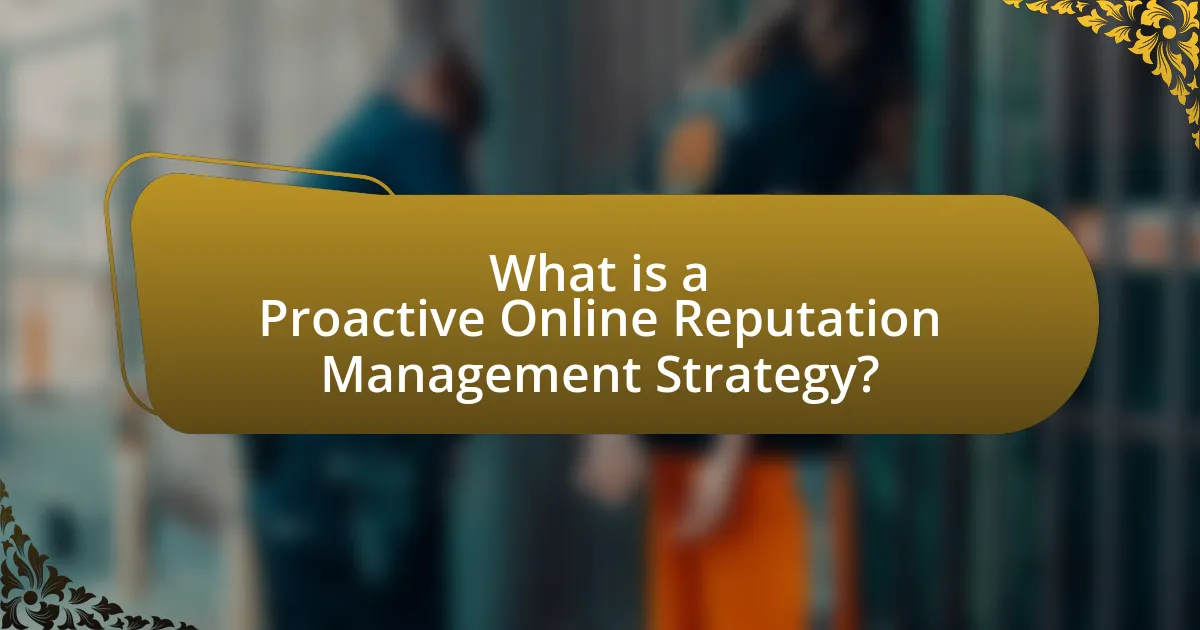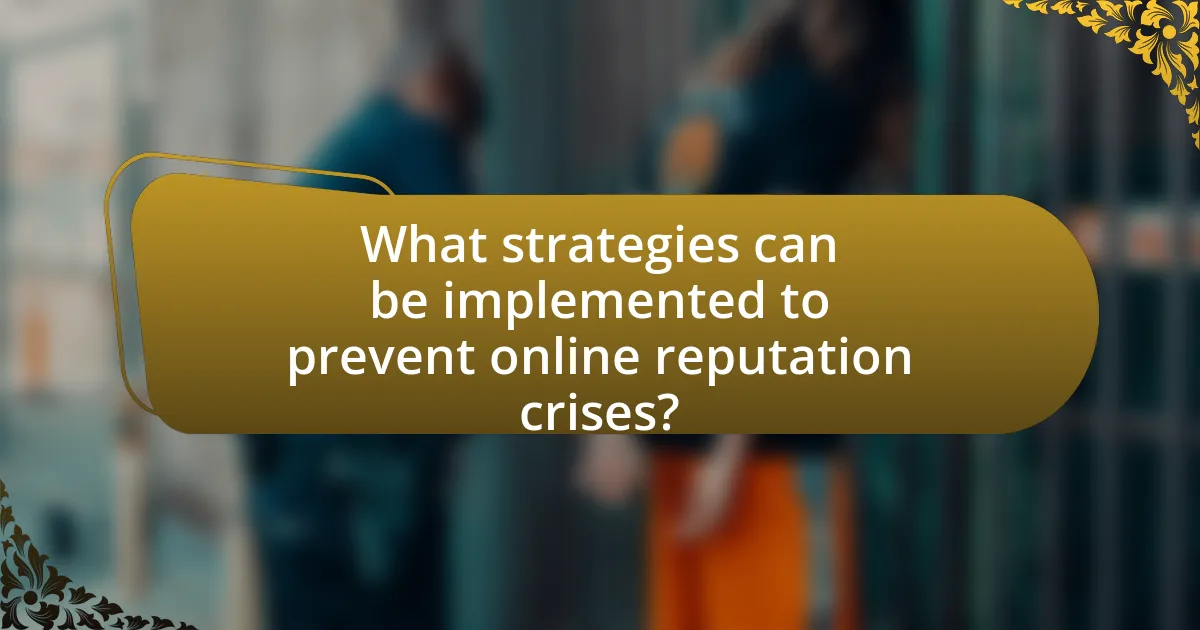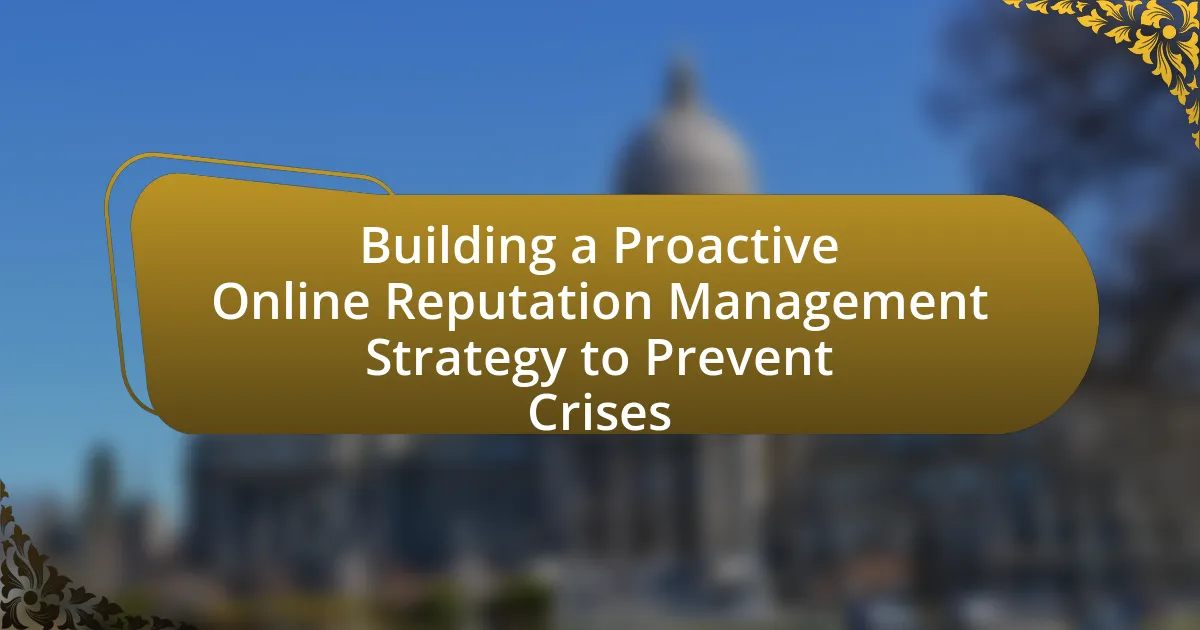The article focuses on building a proactive online reputation management strategy to prevent crises. It outlines the importance of actively monitoring and influencing an organization’s online presence to shape public perception positively. Key elements discussed include the differences between proactive and reactive approaches, essential components of a proactive strategy such as monitoring, engagement, content creation, and crisis preparedness, as well as the risks associated with neglecting online reputation management. The article emphasizes the necessity of adopting proactive measures in today’s digital landscape to maintain customer trust and enhance brand credibility. Additionally, it provides practical tips for assessing online reputation, leveraging social media, and responding to negative feedback effectively.

What is a Proactive Online Reputation Management Strategy?
A proactive online reputation management strategy involves actively monitoring and influencing an individual’s or organization’s online presence to shape public perception positively. This strategy includes regularly assessing online mentions, engaging with audiences on social media, and creating high-quality content that reflects desired values and messages. Research indicates that 70% of consumers trust online reviews as much as personal recommendations, highlighting the importance of managing online reputation effectively. By implementing this strategy, businesses can mitigate potential crises and enhance their credibility in the digital landscape.
How does a proactive approach differ from a reactive one?
A proactive approach involves anticipating potential issues and taking steps to prevent them, while a reactive approach focuses on responding to problems after they occur. In online reputation management, a proactive strategy includes monitoring brand mentions, engaging with customers, and addressing concerns before they escalate, which can mitigate crises. In contrast, a reactive strategy typically involves damage control after negative feedback or incidents arise, often resulting in a more significant impact on the brand’s reputation. Research indicates that companies employing proactive measures can reduce the likelihood of crises by up to 50%, demonstrating the effectiveness of this approach in maintaining a positive online presence.
What are the key elements of a proactive online reputation management strategy?
A proactive online reputation management strategy includes monitoring, engagement, content creation, and crisis preparedness. Monitoring involves regularly tracking online mentions and reviews to identify potential issues early. Engagement focuses on responding to customer feedback and inquiries promptly, fostering positive relationships. Content creation entails producing high-quality, relevant content that showcases the brand positively and improves search visibility. Crisis preparedness involves having a plan in place to address negative situations swiftly and effectively, minimizing damage to the brand’s reputation. These elements collectively help maintain a positive online presence and mitigate risks associated with reputation crises.
Why is it essential to adopt a proactive strategy in today’s digital landscape?
Adopting a proactive strategy in today’s digital landscape is essential because it enables organizations to anticipate and mitigate potential risks before they escalate into crises. In an environment where information spreads rapidly through social media and online platforms, a proactive approach allows businesses to monitor their online presence, engage with their audience, and address issues promptly. For instance, a study by the Pew Research Center found that 64% of adults in the U.S. have experienced online harassment, highlighting the need for companies to be vigilant and responsive. By implementing proactive online reputation management strategies, organizations can protect their brand, maintain customer trust, and ultimately enhance their competitive advantage.
What are the potential risks of neglecting online reputation management?
Neglecting online reputation management can lead to significant risks, including loss of customer trust and decreased sales. When businesses fail to monitor and manage their online presence, negative reviews or misinformation can proliferate, damaging their credibility. According to a study by BrightLocal, 87% of consumers read online reviews for local businesses, and 79% trust online reviews as much as personal recommendations. This indicates that a poor online reputation can directly impact consumer behavior and purchasing decisions. Additionally, companies may face challenges in attracting new customers, as potential clients often research a brand’s reputation before engaging. Therefore, neglecting online reputation management not only jeopardizes existing relationships but also hinders growth opportunities.
How can negative online content impact a business or individual?
Negative online content can significantly harm a business or individual by damaging their reputation and credibility. This impact can lead to decreased customer trust, resulting in lower sales and revenue for businesses, as studies show that 84% of consumers trust online reviews as much as personal recommendations. Additionally, individuals may face personal and professional repercussions, such as job loss or social ostracism, as negative content can influence hiring decisions; research indicates that 70% of employers use social media to screen candidates. Therefore, the presence of negative online content can have far-reaching consequences on both businesses and individuals, affecting their overall success and well-being.
What are some common crises that arise from poor reputation management?
Common crises that arise from poor reputation management include loss of customer trust, negative media coverage, and decreased sales. When a brand fails to address negative feedback or misinformation, customers may lose confidence, leading to a decline in loyalty and trust. For instance, a study by the Reputation Institute found that 60% of consumers would avoid purchasing from a brand with a poor reputation. Additionally, negative media coverage can amplify issues, resulting in widespread public scrutiny and damaging the brand’s image. This can further lead to decreased sales, as consumers are less likely to engage with a brand perceived negatively.

How can businesses build an effective proactive online reputation management strategy?
Businesses can build an effective proactive online reputation management strategy by actively monitoring their online presence, engaging with customers, and creating positive content. Regularly tracking mentions of the brand across social media and review platforms allows businesses to identify potential issues before they escalate. Engaging with customers through timely responses to feedback fosters trust and loyalty, while generating and sharing positive content, such as customer testimonials and success stories, enhances the brand’s image. According to a study by the Reputation Institute, 70% of consumers are more likely to purchase from a brand with a positive reputation, highlighting the importance of proactive management in influencing consumer behavior.
What steps should be taken to assess current online reputation?
To assess current online reputation, begin by conducting a comprehensive audit of online mentions across various platforms. This includes searching for brand names, key personnel, and relevant keywords on search engines, social media, review sites, and forums. Utilize tools like Google Alerts, social listening software, and reputation management platforms to track mentions and sentiment analysis.
Next, analyze the sentiment of the gathered data to determine public perception, categorizing mentions as positive, negative, or neutral. This analysis can reveal trends and areas needing attention.
Additionally, review customer feedback on platforms such as Yelp, Google Reviews, and social media to gauge satisfaction levels and identify recurring issues.
Finally, benchmark your findings against competitors to understand relative standing in the market. This multi-faceted approach provides a clear picture of online reputation and informs necessary adjustments to reputation management strategies.
How can businesses conduct a reputation audit?
Businesses can conduct a reputation audit by systematically analyzing their online presence and customer perceptions. This process involves gathering data from various sources, including social media platforms, review sites, and customer feedback channels, to assess public sentiment and identify potential issues. Tools like Google Alerts, social listening software, and online survey platforms can facilitate this data collection.
Additionally, businesses should evaluate their website and content for consistency in messaging and branding, ensuring alignment with their values and mission. By comparing their findings against industry benchmarks and competitor performance, businesses can gain insights into their reputation relative to others in the market. This comprehensive approach enables organizations to identify strengths, weaknesses, and areas for improvement, ultimately informing their online reputation management strategy.
What tools are available for monitoring online reputation?
Tools available for monitoring online reputation include Google Alerts, Mention, Brand24, and Hootsuite. Google Alerts allows users to receive notifications about new content related to specific keywords, helping track mentions across the web. Mention provides real-time monitoring of brand mentions across social media and online platforms, enabling quick responses. Brand24 offers analytics on online mentions, sentiment analysis, and engagement metrics, which are crucial for understanding public perception. Hootsuite facilitates social media management and monitoring, allowing users to track conversations and mentions across various social networks. These tools are widely recognized for their effectiveness in managing and monitoring online reputation.
How can content creation play a role in reputation management?
Content creation is essential in reputation management as it shapes public perception and influences stakeholder opinions. By consistently producing high-quality, relevant content, organizations can establish authority and trust within their industry. For instance, a study by the Content Marketing Institute found that 70% of consumers prefer to learn about a company through articles rather than advertisements, indicating that informative content can enhance credibility. Furthermore, positive content can counteract negative reviews or misinformation, effectively managing and improving an organization’s reputation over time.
What types of content should be prioritized for positive reputation building?
To build a positive reputation, organizations should prioritize content that showcases customer testimonials, case studies, and educational resources. Customer testimonials provide social proof, demonstrating satisfaction and trust, while case studies illustrate successful outcomes and problem-solving capabilities. Educational resources, such as blogs and webinars, position the organization as an industry leader and build credibility. Research indicates that 79% of consumers trust online reviews as much as personal recommendations, highlighting the effectiveness of testimonials in reputation management.
How can businesses leverage social media for reputation management?
Businesses can leverage social media for reputation management by actively monitoring their online presence and engaging with customers. This involves using social media listening tools to track mentions, comments, and reviews, allowing businesses to respond promptly to both positive and negative feedback. For instance, a study by Sprout Social found that 70% of consumers are more likely to recommend a brand that responds to their social media inquiries. Additionally, businesses can create and share positive content that highlights their values and customer success stories, which can help shape public perception. By maintaining an active and transparent presence, businesses can build trust and mitigate potential crises before they escalate.

What strategies can be implemented to prevent online reputation crises?
To prevent online reputation crises, organizations should implement proactive monitoring, engage in transparent communication, and cultivate positive online content. Proactive monitoring involves regularly tracking brand mentions across social media and review platforms, allowing for early detection of potential issues. Engaging in transparent communication helps build trust with stakeholders, as timely responses to concerns can mitigate negative perceptions. Additionally, cultivating positive online content, such as customer testimonials and case studies, can overshadow negative information and enhance the brand’s image. Research indicates that 70% of consumers trust online reviews as much as personal recommendations, highlighting the importance of maintaining a positive online presence.
How can proactive engagement with customers mitigate risks?
Proactive engagement with customers mitigates risks by fostering open communication and building trust, which can lead to early identification of potential issues. When businesses actively interact with their customers, they can gather feedback and insights that highlight areas of concern before they escalate into larger problems. For instance, a study by the Harvard Business Review found that companies that prioritize customer engagement experience 63% lower customer churn rates. This proactive approach allows businesses to address grievances promptly, reducing the likelihood of negative reviews or public backlash that can harm their reputation.
What are effective ways to respond to negative feedback online?
Effective ways to respond to negative feedback online include acknowledging the issue, apologizing if necessary, providing a solution, and taking the conversation offline when appropriate. Acknowledging the feedback shows that you value the customer’s opinion, which can help to de-escalate the situation. For instance, a study by the Harvard Business Review found that companies that respond to negative reviews can improve customer loyalty by up to 30%. Apologizing when warranted demonstrates accountability, while offering a solution can turn a negative experience into a positive one. Finally, moving the discussion to a private channel, such as direct messaging or email, can prevent further public escalation and allow for a more personalized resolution.
How can businesses create a crisis communication plan?
Businesses can create a crisis communication plan by identifying potential risks, establishing a communication team, and developing clear messaging protocols. First, businesses should conduct a risk assessment to identify scenarios that could lead to a crisis, such as product recalls or data breaches. Next, appointing a dedicated communication team ensures that there are trained individuals responsible for managing the crisis response. Finally, developing clear messaging protocols, including key messages and communication channels, allows for consistent and timely information dissemination during a crisis. According to a study by the Institute for Crisis Management, organizations with a crisis communication plan are 50% more likely to manage crises effectively, highlighting the importance of preparation in mitigating reputational damage.
What role does employee training play in reputation management?
Employee training plays a critical role in reputation management by equipping staff with the skills and knowledge necessary to represent the organization positively. Well-trained employees are more likely to engage with customers effectively, handle complaints professionally, and uphold the company’s values, which directly influences public perception. For instance, a study by the Society for Human Resource Management found that organizations with comprehensive training programs experience a 24% higher employee engagement rate, leading to improved customer satisfaction and loyalty. This correlation underscores the importance of training in fostering a positive reputation, as engaged employees are more likely to act as brand ambassadors, thereby enhancing the organization’s image and mitigating potential crises.
How can staff be educated on the importance of online reputation?
Staff can be educated on the importance of online reputation through structured training programs that emphasize its impact on business success. These programs should include case studies demonstrating how online reputation affects customer trust and purchasing decisions, as evidenced by a 2019 survey from BrightLocal, which found that 86% of consumers read reviews for local businesses. Additionally, workshops can be conducted to teach staff how to manage their personal and professional online presence, highlighting the correlation between individual actions and the overall company reputation. Regular updates on online reputation trends and tools can further reinforce the significance of maintaining a positive digital image.
What best practices should employees follow to protect the brand’s reputation?
Employees should adhere to clear communication, professionalism, and social media guidelines to protect the brand’s reputation. Clear communication ensures that employees convey accurate information, reducing the risk of misunderstandings that could harm the brand. Professionalism in interactions, both internally and externally, fosters a positive image and builds trust with stakeholders. Adhering to social media guidelines prevents employees from posting content that could be damaging or misrepresentative of the brand, as studies show that 70% of consumers are influenced by online reviews and social media interactions. By following these best practices, employees contribute to a cohesive and positive brand image, essential for maintaining reputation in a competitive market.

What are the best practices for maintaining a proactive online reputation management strategy?
The best practices for maintaining a proactive online reputation management strategy include regularly monitoring online mentions, engaging with audiences on social media, and creating positive content. Regular monitoring allows organizations to identify and address potential issues before they escalate, as studies show that 70% of consumers trust online reviews and feedback. Engaging with audiences fosters relationships and builds trust, which is crucial since 84% of people trust online reviews as much as personal recommendations. Creating positive content, such as blog posts and testimonials, enhances brand visibility and counters negative information, as brands that actively manage their online presence can see a 25% increase in customer trust.
How often should businesses review their online reputation strategy?
Businesses should review their online reputation strategy at least quarterly. Regular assessments allow companies to stay updated on public perception, respond to emerging trends, and address any negative feedback promptly. According to a study by the Reputation Institute, organizations that actively manage their online reputation can improve customer trust and loyalty, which are critical for long-term success.
What metrics should be tracked to measure the effectiveness of the strategy?
To measure the effectiveness of a proactive online reputation management strategy, key metrics include sentiment analysis, engagement rates, share of voice, and response time. Sentiment analysis quantifies public perception by analyzing positive, negative, and neutral mentions across various platforms, providing insight into overall brand reputation. Engagement rates track interactions with content, indicating how well the audience connects with the brand. Share of voice measures the brand’s presence compared to competitors, revealing market positioning. Response time assesses the efficiency of addressing customer inquiries or complaints, which is crucial for maintaining a positive reputation. These metrics collectively provide a comprehensive view of the strategy’s impact on brand perception and crisis prevention.
How can businesses adapt their strategy based on changing online landscapes?
Businesses can adapt their strategy based on changing online landscapes by continuously monitoring digital trends and consumer behavior. This involves utilizing analytics tools to track engagement metrics and sentiment analysis, allowing businesses to identify shifts in public perception and preferences. For instance, a study by HubSpot found that 70% of marketers actively invest in analytics to inform their strategies, demonstrating the importance of data-driven decision-making. By staying informed about emerging platforms and technologies, businesses can pivot their marketing efforts, ensuring they remain relevant and effectively engage their target audience.
What practical tips can help businesses enhance their online reputation management efforts?
To enhance online reputation management efforts, businesses should actively monitor their online presence through tools like Google Alerts and social media listening platforms. This proactive approach allows companies to quickly identify and address negative feedback or misinformation, thereby mitigating potential crises. Research indicates that 70% of consumers trust online reviews as much as personal recommendations, highlighting the importance of managing online perceptions. Additionally, engaging with customers through timely responses and transparent communication fosters trust and loyalty, further solidifying a positive online reputation.
What are some common pitfalls to avoid in reputation management?
Common pitfalls to avoid in reputation management include neglecting to monitor online presence, failing to respond promptly to negative feedback, and not having a crisis management plan in place. Neglecting to monitor online presence can lead to missed opportunities to address issues before they escalate, as studies show that 70% of consumers trust online reviews, making it crucial to stay informed. Failing to respond promptly to negative feedback can damage credibility, as 63% of customers expect a response within an hour. Lastly, not having a crisis management plan can result in unpreparedness during a reputation crisis, which can lead to significant long-term damage, as evidenced by companies that have faced backlash without a strategy in place.
How can businesses stay ahead of potential reputation crises?
Businesses can stay ahead of potential reputation crises by implementing a proactive online reputation management strategy. This involves regularly monitoring online mentions, engaging with customers on social media, and addressing negative feedback promptly. Research indicates that 70% of consumers trust online reviews as much as personal recommendations, highlighting the importance of managing public perception. Additionally, companies that respond to customer complaints can improve their reputation by up to 33%, demonstrating that timely engagement can mitigate potential crises.

Leave a Reply